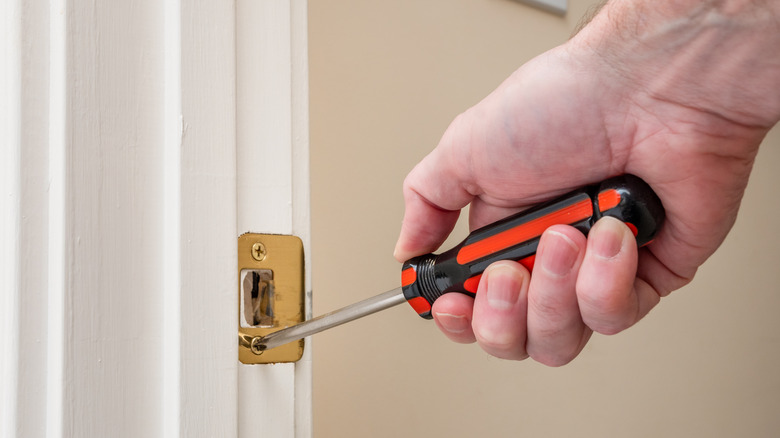The Easy DIY Door Change That Will Make Your Home Safer
More than half of burglars enter homes through the front or back door, and almost three-fourths of the deadbolt locks available for those doors are vulnerable to being kicked in. This problem has what must surely be the easiest, cheapest fix you could dream up: use longer screws for the strike plate that hold your deadbolt in place when the door is locked. That's it... though there are certainly other ways to improve front door security. Based on the price of Grip-Rite construction screws, for 24 cents you can make your door far harder to kick in. When TikTok home improvement DIYer @thefixeronyoutube demonstrates this task, it takes him about 25 seconds to swap out both screws using a cordless drill.
He says this is the first thing you should do when you move into a house or apartment. You're more likely to be burglarized when you've just moved to a new place, and the simplest means burglars use to break through doors is a firm kick aimed right at the deadbolt. Since deadbolts are only seated in the thin door jamb, kicking is often effective. Of course, this trick won't help with "jimmying" a door, prying open the space between the door and the jamb to dislodge the lock's bolt from its strike. And it won't stop a burglar from going through a window. But it eliminates the quickest, easiest means of breaking into your house, and that's pretty good for 24 cents.
The hardest part of replacing your strike plate screws
Even if this isn't the easiest way to make your home more secure, it's very easy. But you do have to have the right screws to do the job. If you use a couple of #12 pan-head screws from your junk drawer, there's a good chance your door won't close properly. Start by having a look at the screws your strike plate is installed with... flat-head wood screws, meaning that the face you can see is flat, and heads that taper quickly to the width of its threads. Look for screws in the same head size (usually #7, 8, or 9) but longer. The best choice is 2 ½- to 3-inch screws, and Kwikset even makes hardened steel replacement screws that are 3 inches long and available in a number of finishes to match your strike plate.
All you really have to do is pull out the old screws and drive in the new ones, securing the strike plate to your home's framing lumber rather than the thin door jamb. You're unlikely to hit any mains wiring even if there's a light switch nearby because exterior doors are typically framed by a king stud and jack stud next to each other... three inches of wood total, on top of the door casing and the strike plate itself. There may be doorbell wiring near the door, but there's usually no reason to run it through the studs and toward the door.
Tips for making the most of this upgrade
Of course, the simpler a fix or upgrade, the more tempting it is to complicate things. And, sure enough, there are a couple of ways to improve a door's security that are also very easy to accomplish while you're standing there. One is to replace the strike plate itself with a strike box (also sometimes referred to as a "box strike"), which is basically a metal cup that lines the hole your deadbolt slides into the door is locked. You will probably have to slightly enlarge the existing hole, and be sure to secure the strike box with long screws as well... usually four of them. Using a box strike and longer screws makes the lock much stronger. While only a little over ¼ of the locks tested by Consumer Reports held up to a kick test. With a box strike and 2" screws installed, all of the locks passed.
Also, remember that the strike plate or box only protects the lock side of the door. It would be wise to replace the hinge screws with longer ones as well but take care not to inadvertently alter the centering of the screw holes, which can make the door misbehave in a number of ways. There are, of course, more and larger screws in an exterior door's hinges than in a strike plate, so it will be stronger than the strike plate side even if you don't replace the hinge screws.

